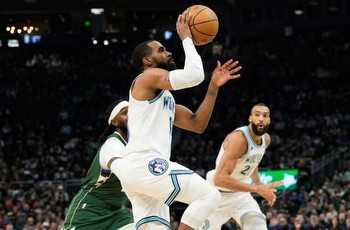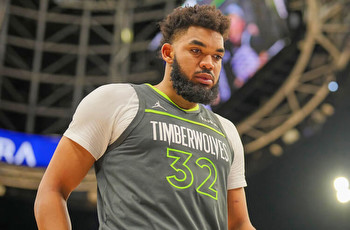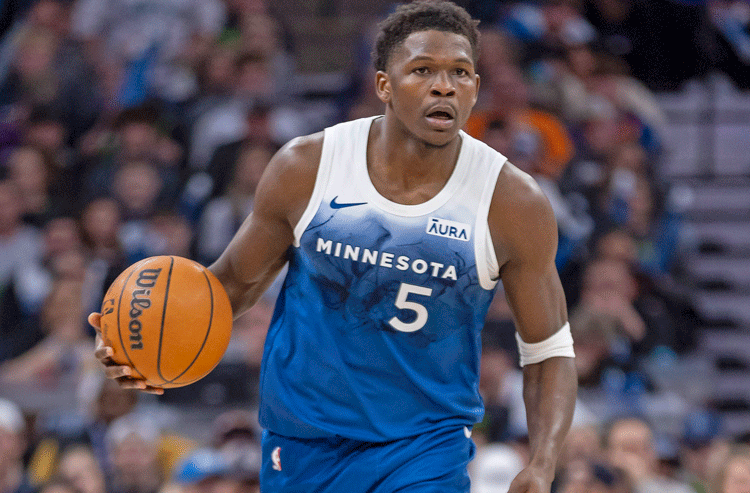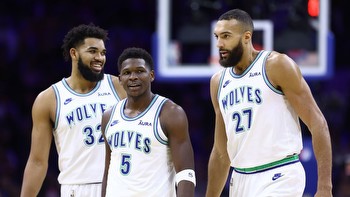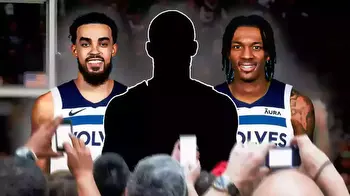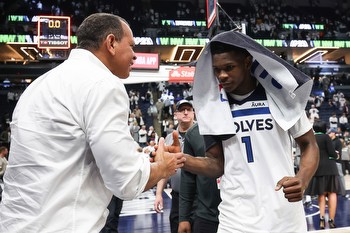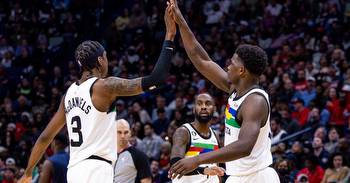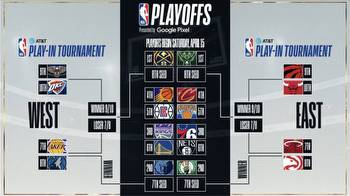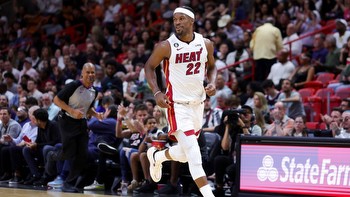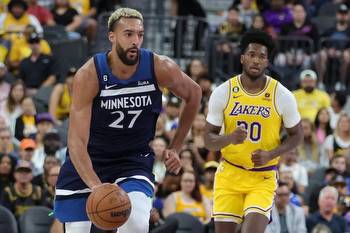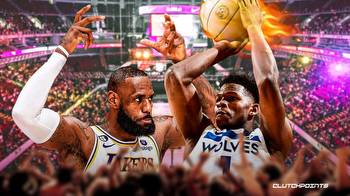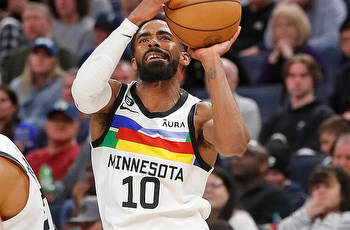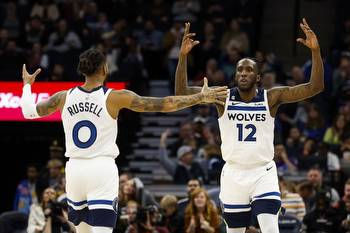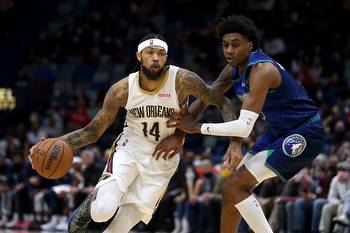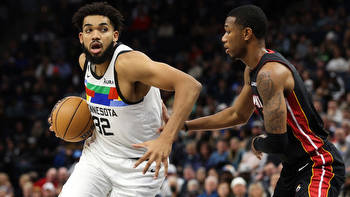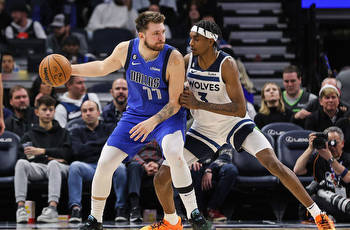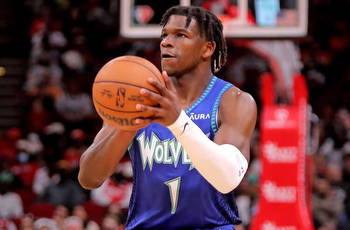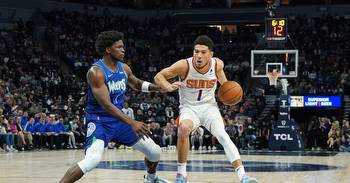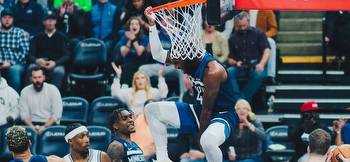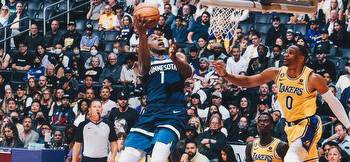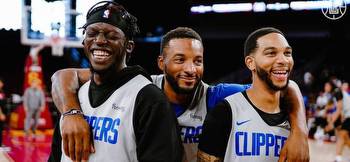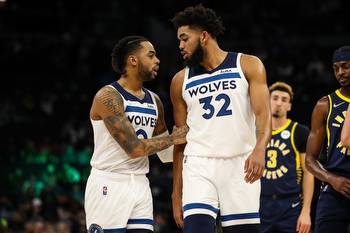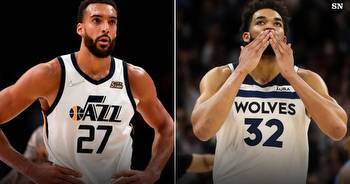Halfway into the season and the Wolves record is the same as last year; but this is not last year’s Wolves
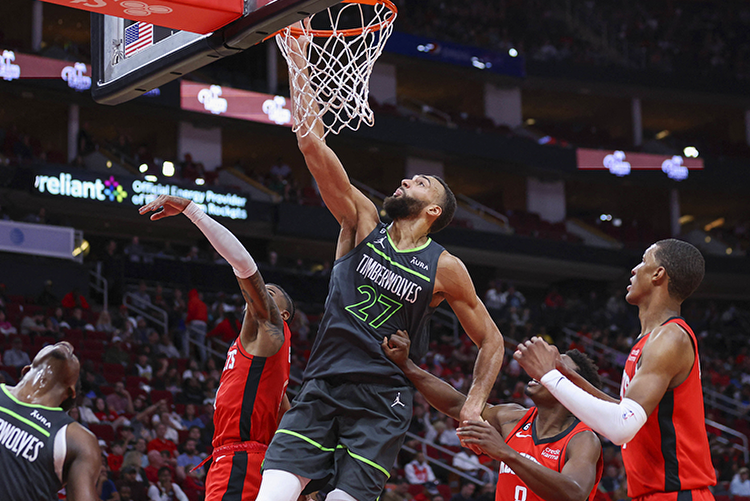
Halfway through the 2022-23 NBA season, the Minnesota Timberwolves are mediocre underachievers, merely sporadic pleasers, and chronic teasers torturing the true believers who bought the bill of goods that this time it would be different.
What is different about the season thus far is the dangling carrot, the notion that, once they are sufficiently familiar with each other, this Wolves roster is now talented enough to become serious contenders for an NBA championship. That was the abiding premise behind the blockbuster trade that brought center Rudy Gobert from Utah in exchange for five first-round draft picks (the final one sacrificed in 2029) and three players who ranked among the Wolves top seven in minutes-played last season.
Yes, the collective talent is impressive. On paper, a starting lineup of Gobert, his fellow All-Star Karl-Anthony Towns, burgeoning star Anthony Edwards, max-salary point guard D’Angelo Russell and defensive stopper Jaden McDaniels was enough for the Vegas oddsmakers to set the betting line on the Wolves win total this season at 48.5.
Through the first 10 games of the season, the won-lost record was 5-5. Ten games later it was 10-10. Ten games after that it was 15-15. And now, exactly halfway through the 82-game slate, the record is 20-21, with a four-game winning streak coming on the heels of a six-game losing streak.
It is the same record posted by the 2021-22 Timberwolves at the halfway mark. But it would be unfair to compare the current conglomeration of Timberwolves to last season’s second-half outfit. Those Wolves proceeded to rip off 22 wins in 31 games over a nine-week span from Jan. 13 to March 19, the third-best record in the NBA, built upon a top-ranked offense that poured in 119.2 points per 100 possessions while playing league-average defense to post the third-best net rating (+7.2 points per 100 possessions) in that period.
It had been nearly two decades since Wolves fans had experienced such a delirious quickening of their basketball team, a hair-raising success story based upon the crowd-pleasing principle of a “fly-around” mentality – run and gun on offense, aggressive pressure to force turnovers on defense.
The KAT/Gobert mix just isn’t mixing
The hangover from that spangled trek through what is typically the slogging, dogsled days of an NBA campaign sharpened the unpleasantness of the Wolves shiftless underachievement to start this current season. A roster taking more than its sweet time aligning the ill-fitting components of its impressive array of skills cannot be cherished as unlikely upstarts. On the contrary, in lieu of a crew of gritty underdogs, ambushing opponents with freewheeling hustle, these Wolves possess enough individual skills to ingrain personal habits that morph into protective privilege. It is crowded at the top of this team’s pecking order, laden with players that, almost in spite of themselves, expect somebody else to grease the small stuff for the greater good.
All players who have a specific extraordinary talent obviously benefit greatly from “role players” who cater to that excellence while shoring up the weaknesses. But that catering requires a more generous and flexible mindset than a skill-driven star usually possesses.
That’s why the notion that Gobert’s defense and KAT’s offense would naturally provide the pair with synergistic ballast at both ends of the court was too simplistic to be true. Yes, Gobert is a defensive dervish, long reputed to be the most intimidating rim protector in the game. But he honed his skills in Utah, where he was the face of the franchise and had the same coach for the past eight years. Even if his Utah teammates weren’t themselves great defenders, everybody knew what Rudy did and didn’t prefer in terms of abetment, and attempted to respond accordingly.
By the same token, KAT has built a reputation as one of greatest shooting big men of all time because he is a matchup nightmare who specializes in taking the man guarding him to the place on the court where he is most vulnerable. But with Gobert necessarily stationed in the paint the vast majority of the time, KAT loses one of the important spaces in his torture chamber.
Ironically, KAT came into this season proclaiming that he was going to “unlock” Gobert’s supposedly latent skills on offense, while Gobert talked about how he could help KAT on defense. In retrospect, it made more sense to have the two bigs lean harder into their respective comfort zones while expending their generosity toward becoming more complementary at the end of the court where they are less capable.
This dynamic isn’t limited to Gobert and KAT. In a similar vein, DLo has confessed that an overemphasis on being more of a pure point guard for Gobert was at least partially responsible for his slow start to the season, especially with respect to his shot accuracy. It’s great that he is shooting better and is overall more effective offensively in his combo-guard role preference. But he’d arguably help the team even more if he could become a more reliable on-ball defender so that Gobert’s rim protection decisions were more predictable.
Coming into this season, excitement about the Wolves was generated by the audacity of pairing two All-Star centers in the starting lineup. Now that we are halfway through, it is fair to say that the awkward fit of Gobert and KAT – in terms of both talent and idiosyncrasies – has become a source of discouragement.
Sure, it can be argued that the mere 401 minutes they have shared the court this season – owing mostly to the calf strain that has sidelined KAT since Nov. 28 – isn’t enough of a sample size for definitive conclusions. And given the amount of treasure sacrificed to obtain Gobert, and resign KAT to a super-max contract, every attempt will certainly be made to maximize their time on the court together. Unfortunately, there is also now the built-in excuse that Gobert and KAT didn’t get enough time this season to thoroughly familiarize themselves with each other.
But it is already clear that this isn’t going to be the natural synergy everyone hoped could occur. The coaching staff will be challenged to come up with wrinkles that transform the two All-Star bigs into effective role players at the other’s more adept end of the court. Maybe there can be more high “4-5” pick and rolls, where KAT curls around a Gobert screen out on the perimeter and has the option of finishing at the rim, lobbing to Rudy, or hitting a teammate for a three-pointer off the drive-and-kick action. On defense, maybe there are switching schemes that mitigate the distance KAT has to move on the perimeter that can still allow him to the part of the rotation-and-contest dynamic that lets Gobert continue to simplify his paint patrol.
The point here is that players have idiosyncrasies that are too often ignored when building a roster. Even players with very similar, high-caliber numbers can arrive at them in very different ways. That’s why they can’t be mixed and matched like swatches of cloth, and why versatile role players are so valuable – and underrated.
Role players, not the names on the marquee will be the difference
Fortunately, delving deeper than the mere sum of roster talent has become a way to both enjoy and feel more optimistic about these 2022-23 Timberwolves in the second half of the season. Some crucial role players are proving their mettle. And some of the most promising young talent have blossomed in a manner that enhances their versatility and provides the organization with more dynamic options moving forward.
Begin with Kyle Anderson, the player that coach Chris Finch presciently knew would be the unsung hero of this roster. Dubbed “Slo Mo” for his distinctively deliberate style, Anderson is the player who has made Gobert feel most at home in Minnesota – in part because he too is an established veteran newly arrived on the Wolves after many years with franchises renowned for their quality control.
After nine years in Utah, Gobert is understandably a creature of habit who, even more than most players, thrives when he can rely on teammates doing what they are supposed to do. Nobody on the roster is more reliable than Slo Mo, who learned fundamentals from a Spurs organization not far removed from the peak of its dynasty, and physicality from a Grizzlies franchise long synonymous with grit.
On lobs, entry feeds, and rolls off picks, Gobert likes to see the ball high, coming straight out of the passer’s hand. Anderson is so good at it that many times you don’t know if he is shooting or passing. On defense, Gobert wants to know his teammate won’t be overpowered in the paint and will make the right decision on when to rotate and when to stay at home. Aside from an occasional tendency to stray on help defense, Slo Mo checks both boxes.
The synergy between the two is remarkable. Gobert has played at least 300 minutes beside seven different teammates thus far this season. In the 404 minutes he has shared the court with Slo Mo, the Wolves score 113.2 points per 100 possessions – nearly five points better than his next most effective partner on offense, Ant, who has teamed with Gobert for 108.5 points per 100 minutes in the 872 minutes they have shared the court.
Defensively, the Gobert/Anderson tandem has helped the Wolves allow just 103.7 points per 100 possessions in those 404 minutes. The next best defensive pairing for Rudy on the court is the 107.3 points per 100 possessions that he and KAT have yielded in their 401 minutes. Of course, KAT and Gobert helped the Wolves score only 106.6 points per 100 possessions in that time, just as Ant’s offensive effectiveness with Rudy is offset by the fact that the Edwards-Gobert defensive performance in their shared time is 109.5 points allowed per 100 possessions.
Bottom line, when Gobert and Anderson share the court, the Wolves score 9.5 more points per 100 possessions than they allow. None of the other six players who have spent at least 300 minutes on the floor with Gobert enable the Wolves to have a positive net rating – the closest is Rudy and Jaden McDaniels, who combine to help their team score 107.7 and allow 107.8 for a -0.1 net rating.
Another vital role player is Taurean Prince, whose return to action after missing nearly six weeks (all of December) with a shoulder subluxation has been a catalyst in the last three victories of the team’s current four-game winning streak. Like Slo Mo, Prince is a combo forward, although he is more of a small forward while Anderson is more of a power forward for the Wolves this season. After floundering during the first two months of the 2021-22 campaign, Prince was a stalwart presence both on the court and in the locker room the remainder of that campaign. He agreed to come back on a two-year deal that pays him slightly more than half per season than what he was making in 2021-22. Thus far, that contract is a steal for the Wolves.
Nobody on the Wolves current roster combines a “fly around” mentality with a high court IQ with the impact Prince brings to the NBA game. On or off the dribble, he moves his feet and makes quick decisions. He is superb at closing out on perimeter shooters but is also the best on the team at standing his ground and taking charges in the paint. His shot selection is aces for both when and where he shoots. And he has a nasty, enforcer, side to him that provides a needed edge to the team’s attitude.
Like Slo Mo, Prince is above all reliable. The night he returned from injury, Finch described how and why he was missed. “I knew what I was going to get from him every night. He knows who he is, his game is super well-defined, and he sticks to his strengths.”
Ant growing into elite player
Having the security blankets of veterans like Prince and Slo Mo off the bench is a key reason to feel good about the Wolves in the second half of the season. So is the eventual health of Jordan McLaughlin, a superior performer off the bench for Wolves last season, who was again effective before a chronic calf strain has caused him to miss all but three of the past 24 games.
But, as chronicled in some detail in my column last week the best recent news for Wolves fans has been the sustained development of their two starters still on their rookie contracts, 21-year-old Edwards and 22-year old McDaniels.
Ant always shone the potential to become an elite scorer, but this season he has added playmaking and a heightened court awareness to his arsenal. As teams send two or more defenders at him, he has learned to recognize when to simply get off the ball with a simple pass and when the opponents’ gambit has created the conditions for an easy assist. He has learned when to rise up for a trey and when to put the ball on the deck.
As a shooter, he remains a legitimate threat as a volume scorer from behind the arc attack, while improving the finesse of both his footwork and his finishing touch on the shot off dribble penetration. He is entering the zone reserved for star playmakers like Jason Tatum and Paul George, who are entrusted to take over games in clutch situations by whatever means necessary and the organization is content to live with the results.
Without question, the first half of the 2022-23 season will be known mostly for the ascendance of Ant, a phenomenon that will significantly impact how this organization plans for the near and long-term future of the franchise.
While not as dramatic, the growth of McDaniels is a huge boon to a franchise that punted so many future assets to acquire Gobert. Having a young starter who you can match up with an opponent’s top scorer almost regardless of position is an asset to be cherished. Having that player start to emerge as a genuine two-way threat via an expanded range of scoring skills – via more confident aggression, smarter shot selection, and an heretofore unknown assortment of moves to the hoop – is the sort of unexpected serendipity that is a common ingredient in any team’s rise to genuine championship contention.
What’s been working these past four games?
Over the past few games, Finch has deployed all of his good-news crew together on the court, surrounding Gobert with Slo Mo, Prince, McDaniels and Ant. It is a lineup that allows Rudy to patrol the paint while it flies around the perimeter on defense, large and limber enough to switch assignments easily, intelligent and gritty enough to sustain the flow of coverage and intensity.
On offense, it is a lineup tailored for this new, profound Ant – none of his four teammates need the ball to be effective, but all know how to move so defenders must take notice, and know what to do if the ball does find them. Nobody is a great dribbler but all can quickly move the ball and provide easier targets for the teammate who is dribbling.
The sample size is tiny – a miniscule 13 minutes with all five on the court – but the analytics are as eye-popping as the eye test. On offense, 146.2 points scored per 100 possessions. On defense 69.2 points allowed per possession. Net rating: +76.9.
The takeaway isn’t that the Wolves have found a “death lineup” that will carry them deep into the playoffs. It is that smart, versatile players purposefully working in sync and taking their cues from the acknowledged star or two on that end of the court are how you stack wins and playoff appearances in the NBA. May the Wolves turn their sails to reap the windfall of those circumstances as much as possible in a disappointing season that is not yet lost.
In my ongoing desire to connect more frequently with readers, I’ll be holding a Zoom conversation tonight at 5 p.m. before the 6 p.m. road game against the Pistons in Detroit to kick off the second half of the season. I sincerely hope many of you can make. If things go as usual, I’ll pretty much be taking questions for the entire hour, so stop on by.

